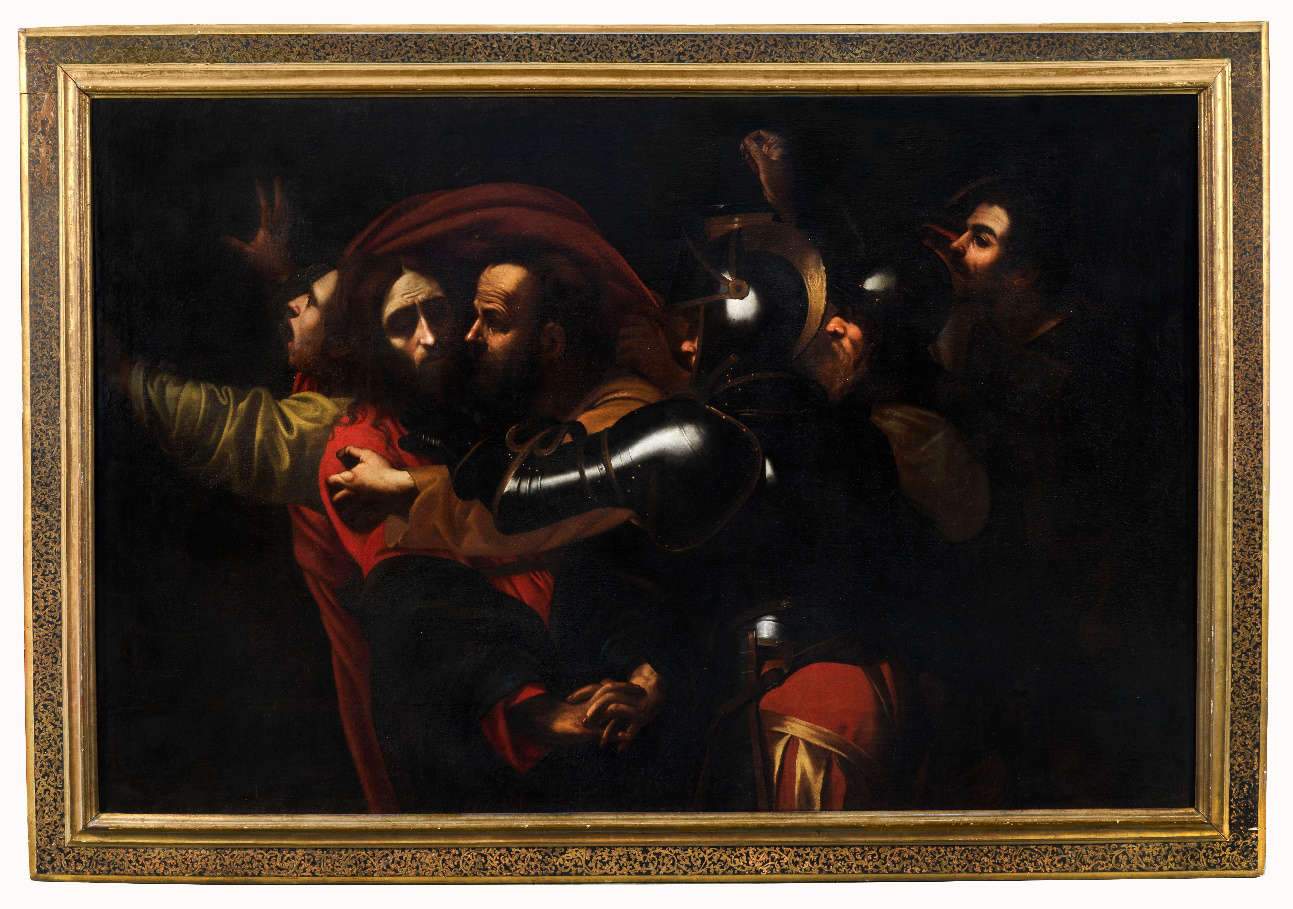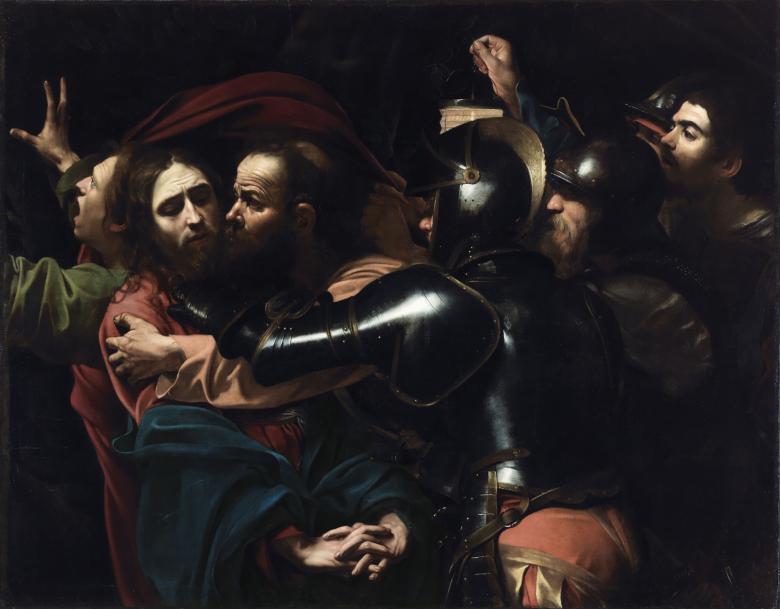The Taking of Christ from the Ruffo collection, an invention of Caravaggio, is on display in Naples
At the Fondazione Banco di Napoli, from March 2 to June 16, 2024, the exhibition of the painting The Taking of Christ, an important version of a well-known work by Michelangelo Merisi da Caravaggio, curated by Francesco Petrucci and Don Gianni Citro. The work, before arriving in the spaces of Palazzo Chigi in Ariccia (Rome) last year and now in Palazzo Ricca, had been exhibited only in 1951 at the historic Exhibition of Caravaggio and the Caravaggeschi, curated by Roberto Longhi (who had found it in 1943), when it was dirty and with various repaintings, which were removed after the recent restoration. It is one of the most intense and pathos-rich compositions of Caravaggio’s Roman activity, of which two autograph versions can be traced: the one now on display at the Fondazione Banco di Napoli and the one from the Jesuit Company in Dublin, on deposit at the National Gallery of Ireland since 1993.
The two versions are endowed with formal and expressive autonomy, with a precedence, according to the curators of the exhibition, of the Ruffo version, of which the Irish one would thus be a replica with variants revisited in pictorial and layout characteristics. The exhibition will be accompanied by didactic panels that give an account of the history of the composition, through research of the numerous copies and variants and careful documentation of all the diagnostic results made in the last two decades. The exhibition is completed with documentary and multimedia insights in the museum’s ilCartastorie spaces. From the archival documentation we move on to the museum’s multimedia narratives, first among which is the one dedicated to Caravaggio, and then go on to discover the richness of the stories contained in the writings of the Banco di Napoli Historical Archives, which recently became part of the UNESCO heritage.
The exhibition is set up on the piano nobile of Palazzo Ricca, in Baroque rooms adorned with vaults frescoed by Giacinto Diana. The display involves five of the rooms of the Palazzo Ricca’s noble apartment and also includes the opportunity to visit the Cartastorie Museum and related narrative installations. Visitors will also have the opportunity to immerse themselves in the history of the Lombard painter’s first Neapolitan sojourn, as documented in the ancient registers of Neapolitan public banks. This experience will be made possible thanks to a dedicated space in the museum, where three important documents are preserved: the commission from the merchant Nicolò Radolovich to the master for an altarpiece, dated Oct. 6, 1606, which represents the first certain evidence of Caravaggio’s presence in Naples while fleeing Rome; the payment for the creation of the most representative of this sojourn, the Seven Works of Mercy, dated Jan. 9, 1607; a document dated May 11, 1607 regarding the Flagellation, once located in the Neapolitan church of San Domenico Maggiore, currently on display at the Museo Diocesano - Complesso Monumentale Donnaregina.
Enthusiasts of Michelangelo Merisi will have the opportunity to admire a work that, after being exhibited only in 1951 at the historic Caravaggio and Caravaggeschi Exhibition, curated by Roberto Longhi at the Palazzo Reale in Milan, was recently restored and displayed in the Palazzo Chigi in Ariccia (Rome), before coming to the Palazzo Ricca. Investigations revealed significant changes and pentimenti, which, according to scholar Francesco Petrucci , would confirm the autographism also recognized by other scholars since the painting’s resurfacing in 2003. Because of its importance, the painting was declared a work of special interest to the nation by a Dec. 2, 2004 Decree of the Minister of Cultural Heritage.
This exhibition will also document the provenance of the work, including the Mattei collection, the Colonna di Stigliano collection and the Ruffo di Calabria collection, through which it came to its current owner. The exhibition is accompanied by educational panels that will illustrate the history of the composition, including research on the various copies and detailed documentation of all the diagnostic results obtained over the past two decades.
The Taking of Christ, belonging to the Mattei collection, constitutes a privately intended equivalent of the canvases in the Contarelli chapel in San Luigi dei Francesi (1599-1600) and the Cerasi chapel in Santa Maria del Popolo (1600), which mark a radical expressive turning point in the Lombard artist’s production, after a period in which genre subjects and mythological themes prevailed. The exhibition will also investigate the controversial history of Caravaggesque’s innovative creation and its pictorial evidence, with particular emphasis on the two versions from the Ruffo di Calabria collection, rediscovered by Roberto Longhi in 1943, and from the Jesuit Company in Dublin, kept at the National Gallery of Ireland since 1993. The two versions exhibit considerable formal and expressive autonomy. The Ruffo version, i.e., the one exhibited in Naples, is considered here to predate the Irish version, which would present variants that modify its pictorial and compositional characteristics, coming closer to a classical decoration from an iconographic and aesthetic point of view, as opposed to the strong “expressionist” and dramatic charge of the prototype.
No other work by Caravaggio has experienced such a troubled collecting history in its major versions, with episodes that seem straight out of a thriller novel: a daring theft, a complicated court case, and even the publication of a book about his adventures. These events alone would merit an in-depth analysis. The complexity of the iconographic, iconological and conceptual structure and content of The Taking of Christ, which has no equivalent in Caravaggio’s works for private use, make it worthy of a monographic study, the focus of this exhibition event.
The event is produced in close collaboration by the Fondazione Meeting del Mare C.R.E.A. (Culture, Religions and Art) and the Fondazione Banco di Napoli. For all information, you can visit the official website of ilCartastorie.


Statements
“The Taking of Christ exhibited in the rooms of Palazzo Ricca is the most important discovery of Caravaggio’s work in recent decades because of the complexity of the composition and the spiritual content it expresses,” explains Francesco Petrucci. “Caravaggio is a conceptual painter, and what interests him above all is the expressive content. The painting, which returns to Naples, where, in the Colonna di Stigliano collection, it had presumably remained until about 1830, is the first version of the Taking of Christ, followed, then, by the Dublin replica, which does not have the same expressive power, is much smaller and does not have the black frame guilloche-worked in gold, which the prototype had. Frame, moreover, common to other Roman works by Merisi. The work exhibited in Naples appears in the corpus Mattei inventories with such a frame; it also has numerous pentimenti typical of an early version, absent from the Irish replica.”
“Returning this Caravaggio masterpiece to the world of Art and Civilization has become a kind of humanitarian mission, as well as a cultural one, in which I took part with great enthusiasm, resulting in an effective collaboration between the Fondazione Meeting del Mare C. R. E. A. and the Fondazione Banco di Napoli, which is hosting the event,” says Don Gianni Citro. “The exhibition of The Taking of Christ in the city of Naples, which welcomed Caravaggio as a fugitive and frightened man and led him on a quest for Mercy and Redemption, is an indication of a cultural journey that is being charged with ever new provocations, starting with the frantic race toward freedom of one of the greatest artists of all time, to the silent quest and invisible goals of every daily user of this event, enclosed in a segment of art and spirit.”
“With the inaugural Exhibition, the Fondazione Banco di Napoli intended to strengthen its presence in the world of art, where it is active in various ways, in accordance with its tasks of supporting this high form of human creativity,” says Orazio Abbamonte, president of the Fondazione. “With the presence in Palazzo Ricca of the painting attributed to the great Lombard painter, which has been exhibited to the public only one other time in the past seventy years, the Foundation intended not only to pay further recognition to an author who in the City worked and lived, leaving as a testimony very important canvases, but also wanted to place at the disposal of Neapolitans and those who wish to observe the canvas, a work of the finest workmanship, capable of arousing very intense feelings and thoughts about human nature in the presence of the divine that few other artistic pages have been able to describe.”
“The exhibition of Caravaggio’s masterpiece represents a formidable opportunity to open the Fondazione Banco di Napoli and the Museum of the Historical Archives to the city, and to an ever-growing public, testifying once again to its extraordinary function as a new driving force and reference point for the history of Neapolitan culture,” stresses Marcello D’Aponte, president of the Museum of the Historical Archives of the Banco di Napoli. “The initiative fits perfectly into the groove of a series of growing and increasingly significant activities aimed at fighting degradation and fostering social integration, further respecting and enhancing, and even in this way, the mission of the Fondazione Banco di Napoli.”
 |
| The Taking of Christ from the Ruffo collection, an invention of Caravaggio, is on display in Naples |
Warning: the translation into English of the original Italian article was created using automatic tools. We undertake to review all articles, but we do not guarantee the total absence of inaccuracies in the translation due to the program. You can find the original by clicking on the ITA button. If you find any mistake,please contact us.



























